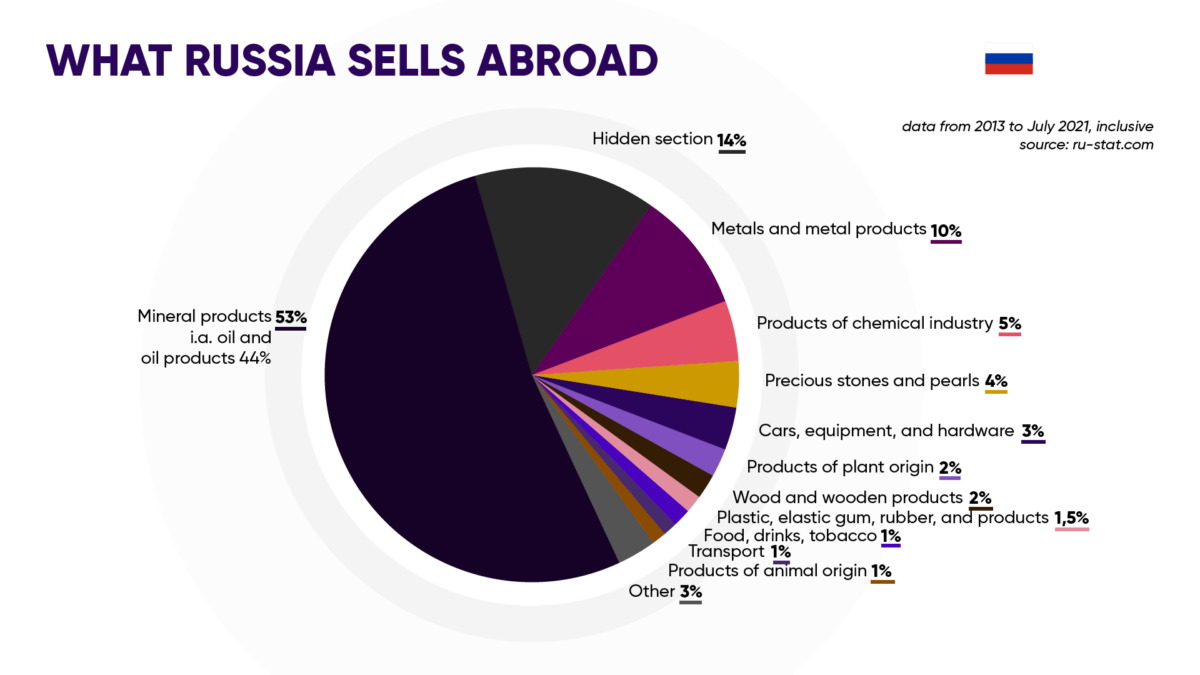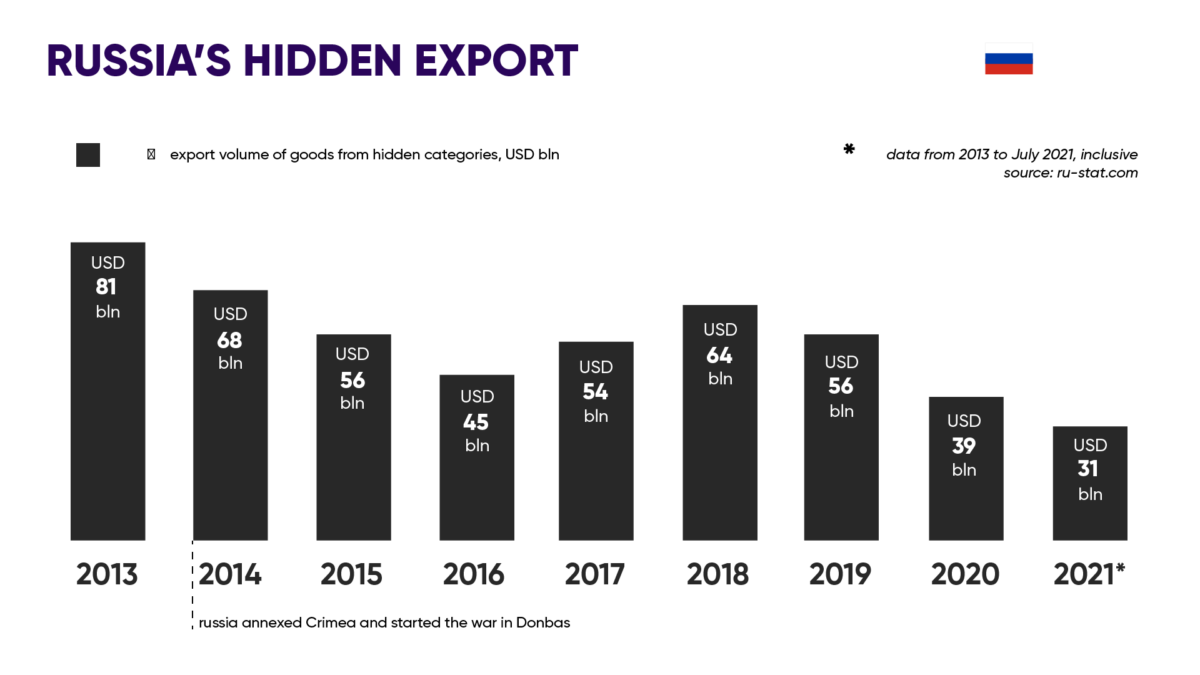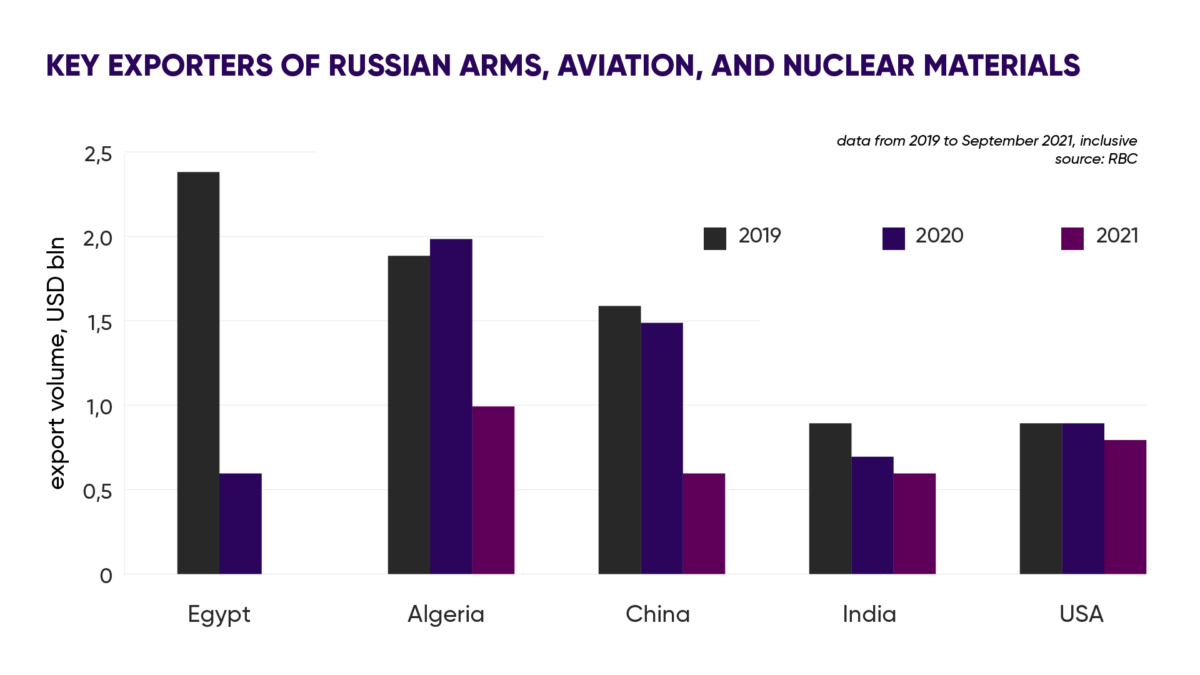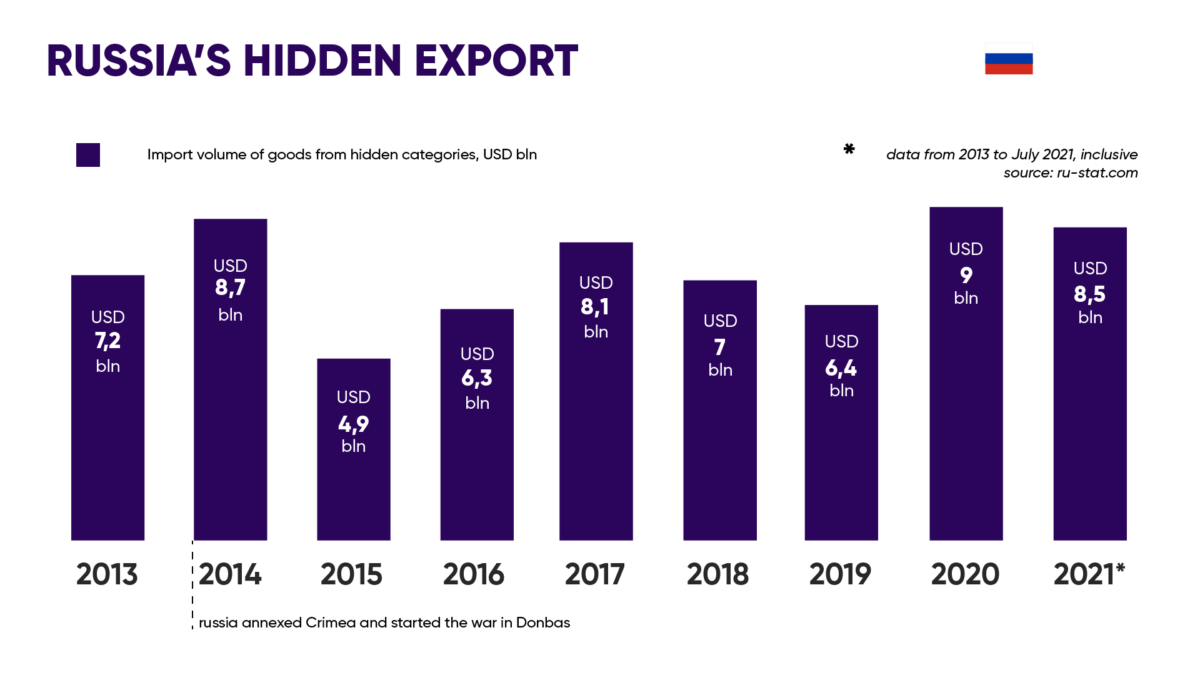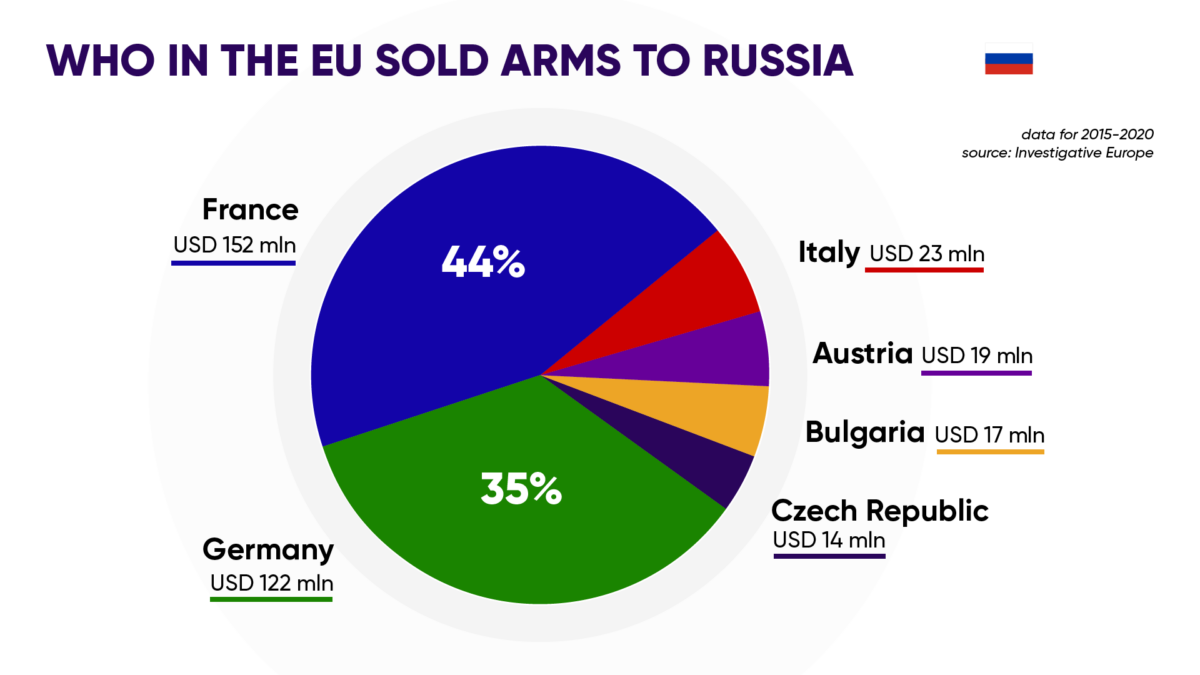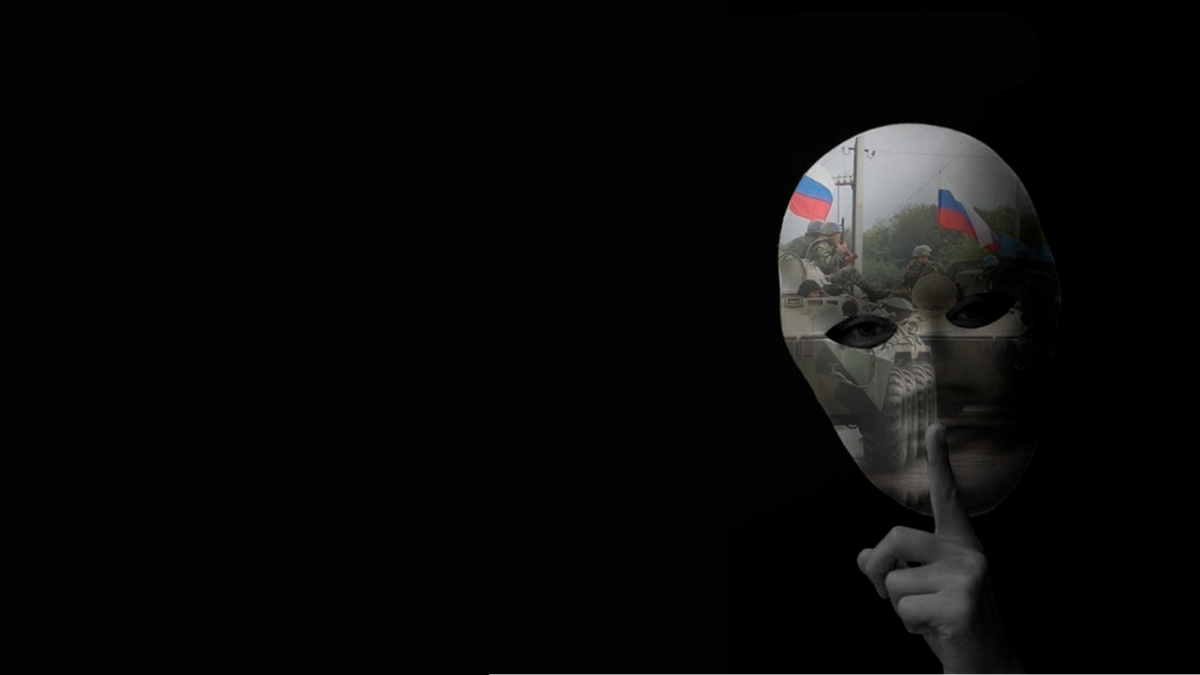

From January 2013 to July 2021, russia earned almost USD 3.5 trln in exports. More than half of these profits come from the sale of various mineral products, including petroleum ones. The “hidden” (secret) section ranks second, its share was 14.2%.
Secret export is the sale of goods to other countries, which is recorded in hidden sections of customs statistics. The categories of such export in the commodity nomenclature of foreign economic activity have codes with several signs that include the letter S: SS, SSSS, etc.
Goods whose sales russia conceals include:
– weapons and ammunition;
– spacecraft, aviation (both military and civil) and spare parts for them;
– warships;
– tanks and other self-propelled armored vehicles;
– rare earth metal compounds;
– radioactive elements and isotopes;
– natural gas
We analyzed data on secret export/import of russia from open sources to find out to whom the rf sells weapons and from whom it buys them. The material uses data for different periods — since the sources of information on total imports/exports, the main exporters of goods of the hidden category, and arms exports from the EU to the rf — are different.
Export
Russia’s secret exports in the widest possible coverage from January 2013 to July 2021 amounted to more than USD 490 bln. The rf sold the most goods of this group in 2013 — for more than USD 80 bln. After the annexation of Crimea and the beginning of the war in the East of Ukraine, the volume of secret exports decreased noticeably. The rf earned the least from it in 2016 — only USD 44.6 bln.
What does russia sell so secretly? According to RBC, in 2019, 75% of russia’s secret export was pipeline gas, the rest were weapons, aircraft, and isotopes. According to Vedomosti, in 2021, the share of natural gas in the structure of russia’s secret export was at the same level — 74%.
In addition, the largest importers of russian secret goods in 2013-2021 were not traditional buyers of russian weapons and ammunition, such as Egypt, Algeria, China, India, but completely peace-loving democratic countries:
– Germany — 18.4%;
– Turkey — 11.3%;
– Italy — 8.7%;
– England — 5%;
– France — 4.7%;
– Austria — 2.8%;
– Czech Republic — 2.4%;
– USA — 1.9%.
The leading countries in terms of purchasing secret russian export coincide with the largest buyers of russian gas. Thus, in 2021, Germany purchased the largest amount of russian gas — 48.2 bln m³, or 23.7% of total gas export from the rf. Turkey comes second — 26.8 bln m³ — 13.2%.
Who buys weapons from russia? In 2019, the largest importers of russian defense products, including a relatively small share of civil aviation and chemical compounds, according to RBC, were:
– Egypt (USD 2.4 bln);
– Algeria (USD 1.9 bln);
– China (USD 1.6 bln);
– India and the USA (USD 0.9 bln each).
At the same time, Egypt and Algeria almost did not import secret chemical compounds.
In 2020, Algeria (USD 2 bln) and China (USD 1.5 bln) purchased the most russian weapons.
According to the results of 9 months of 2021, Algeria was also the largest buyer of russian military products. The rf mainly supplied it with the aviation equipment and armament. Algeria, in particular, buys Su-57E and Su-35 fighters, Su-34 bombers, corvettes, submarines from russia. Egypt imports various air defense systems, artillery, small arms, fighters, and combat helicopters from russia.
Import
From 2013 to July 2021, russia purchased goods from a classified group in the widest possible coverage for more than USD 66 bln. The largest increase in 2020 was by USD 9.06 bln, and in 6 months of 2021 — by USD 8.5 bln.
Interestingly, in 2014, imports of secret goods to russia increased by 17% compared to 2013. The same year, the rf annexed Crimea and launched a war in Donbas.
Almost half (47.2%) of the total import of the “classified” group of goods for the period under consideration falls on the USA. France ranks second, with 26.6%, Germany — third, with 4.4%. According to the UN, the predominant share of classified import is Boeing and Airbus commercial aircraft (America and France, respectively). However, the West supplied russia with weapons and military equipment as well.
In July 2014, the EU Council banned selling arms, military equipment, and dual-use goods to russia. However, many European countries have continued to do so.
How have European companies circumvented the embargo to sell arms to the rf? Investigative Europe journalists in their study say that countries that exported weapons to russia used a legal loophole. The EU arms embargo contains the following exceptions: contracts concluded before 1 August 2014, or ancillary contracts necessary for the execution of such contracts. That is, the companies simply concluded additional agreements to the old contracts — and continued to supply military equipment and weapons to the rf. However, the Working Party on Conventional Arms Exports (COARM) sees no loopholes in this.
Another way to circumvent the ban is to export dual-use goods to russia, which can be used in both civil and military spheres. For example, the Armed Forces found German Bosch parts in russian military equipment. Subsequently, the manufacturer announced that it would curtail all its activities in the rf. The European Union banned the export of such goods to russia on February 25, 2022.
According to official russian data, even Ukraine itself continued to supply weapons and ammunition to the rf. For the period 2013-2021, imports of this group from Ukraine amounted to USD 278 mln. According to the Stockholm International Peace Research Institute (SIPRI), russia became the second-largest buyer of Ukrainian weapons (36% of total arms export from Ukraine) in 2016-2020. The first is China.
The largest arms exporters to the rf in 2015-2020: a study by Investigative Europe
According to Investigative Europe, France supplied the most weapons to russia in the period 2015-2020. It sold military equipment to the rf for EUR 152 mln. Overall, the French share in arms exports from the EU to russia is 44%.
The French edition Figaro reports that France has issued at least 76 licenses for the export of military equipment to russia from 2015 to 2020. The edition notes that despite the embargo on the supply of weapons to the rf, France continued to implement previously signed contracts — that is, it used the loophole in the ban.
The French government reacted promptly to this information and stated that these deliveries were not contrary to the legislation at that time. And they really weren’t. At the same time, in those years, France had to go for the cancellation of the contract for the construction of two Mistral amphibious assault ships.
According to Disclose, French export also includes thermal cameras for more than 1,000 russian tanks, navigation systems, and infrared detectors for fighters and combat helicopters. The kremlin bought them from Safran and Thales, whose main shareholder is France. This equipment is found aboard russian tanks, fighters, and helicopters, which are currently in Ukraine.
Germany exported EUR 121.8 mln worth of military equipment to russia (over 35% of European arms export to the rf). We are talking mainly about ice-breaking vessels, rifles, and “special protection” vehicles. German export is labelled as dual-use goods. This is why even German politicians who criticize arms export and pacifist NGOs contacted by Investigate Europe do not consider export a legitimate violation of the embargo.
Italy comes third in terms of export, having sold EUR 22.5 mln worth of military equipment to russia between 2015 and 2020. According to the investigation, Italy’s first major contract with russia was signed in 2015, when the government of Matteo Renzi allowed the Italian company Iveco to sell ground vehicles to russia worth EUR 25 mln. Military vehicles — the Lynce model manufactured by IVECO — were noticed by a journalist of the La 7 TV channel in Ukraine in early March 2022. These vehicles were assembled at one of Iveco’s three factories in russia, but using Italian parts.
Austria also continued to export annually military equipment, smooth-bore weapons of less than 20 mm caliber, automatic weapons of 12.7 mm caliber and ammunition, explosive devices, and other weapons to russia.
Bulgaria concluded two agreements in 2016 and 2018 for the supply of warships, special naval equipment, accessories for EUR 16.5 mln.
We see that the previous European bans on supplying weapons to russia had loopholes. It was because of them that some countries and companies partly continued to sell military equipment, weapons, and ammunition to the rf. At the same time, Ukraine also traded arms with russia.
We can’t change the past. However, it is now critical to close all these sources of armaments to the occupying country. Recently, the EU has renewed its embargo on arms sales to the rf. Likewise, dual-use goods came under sanctions.
We hope that these bans will work better and longer than previous ones. Once again, we call on the EU to impose an embargo on oil and gas. It is trade in them that brings russia the greatest profits and, accordingly, will hit the russian economy the hardest.




